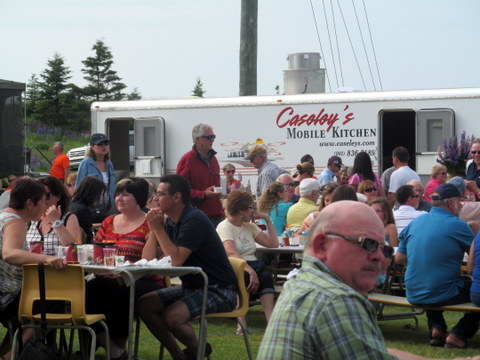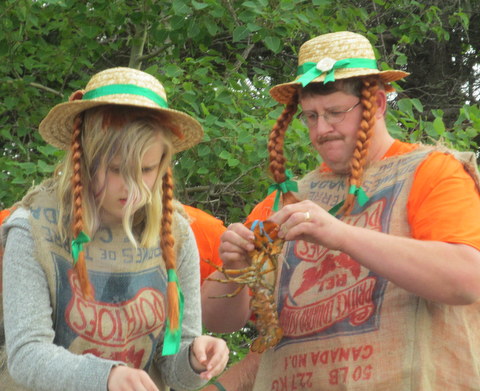I toiled last summer to design and outline a
seven-circuit labyrinth in the “back 40” at the cottage. Then the lawn guys
carved out the path.
Greg collected and placed rocks to define
where it leads. Last, I covered the path with mulch to keep the weeds at bay.
In September just before we left, we planted
bunches of three daffodils each around it — 28 bunches in all, as it turned out,
a nice coincidence with their being 28 days in the lunar month. Unlike the
labyrinth at Chartres, the seven-circuit type doesn’t have actual lunations to
mark the lunar calendar, but the little clumps of daffodils were a reminder of
the moon and all it signifies.
It was neat and tidy when we left last fall. In
fact, practically all labyrinths I have encountered are just that—neat, tidy,
and dare I say, almost perfect. Here is the one at the convent of the Sisters
of St. John the Divine in Richmond Hill:
 |
| Source of photo: http://www.ssjd.ca/labyrinth.html |
It is similar to mine because it its outlined in stones.
So you can imagine how I felt when we
returned this spring and found this:
My first thought was: oh no, it is so overgrown! In fact, it was so invaded by dandelions I thought I should call it a
dandelinth. The daffodils were slightly past their prime, their yellow
completely outshone by the dandelions’.
My dismay was assuaged by the fact that the path was
still visible, and I enjoyed walking around it while looking at the various
stones. They were all the same (red sandstone) yet unique (in shape and
size).
I thought about this difference
in sameness for a while and also about rocks: calm, solid, perpetual,
unchanging.
Of course, I immediately began to weed as I walked. Then
I reflected that I was treating the labyrinth as a thing to be worked on rather
than as a means for inner quiet, meditation, and even mystical experience. None
of the other labyrinths I had enjoyed required my on-going care and keeping. They were usually made of
cement and other materials which prevented the infringement of weeds. On them,
I could just quiet my ego and follow the path on an inner pilgrimage. This one pleaded
for my objective attention and hence, the engagement of my ego.
So at first I thought what a pity it was that I did
not have the “right” attitude towards it. Would I ever feel I was not working
on it as merely an artefact and just let myself experience what walking its
path offered my inner Self, my soul?
So then I
decided I would pull weed weeds from the path only on the way in. Being bent
over and humbly weeding would suit the penitential nature of the way to the
centre, at least according to one way of looking at the walk in. Each weed could be a flaw in myself or a trouble in my world or a
trouble in the world at large, which needed to be pulled for personal and
worldly improvement nay, even perfection.
Then on the way out, I would refrain from working on
it and have a true Sabbath — a time of opening my soul to whatever God/the holy
spirit/the divine within/the mystery of nature wanted to put there. It would be
redemptive.
Unfortunately, it didn’t work out that way. In or
out, I could not resist pulling up the twitch grass, dandelions and other weedy
things.
Then I had something of an epiphany. It is all right
to be a Martha working all the time: Unlike the biblical Martha, I was enjoying it. It had a
rhythm. Yet, I did not feel impelled to totally weed everything, nor did I weed with any
pattern or intent: A swath of twitch
grass which I had been happy to ignore going in would attract my attention
coming out.
So, not only was the labyrinth not perfect, neither apparently
was my plan to do things right.
I reflected on the word perfect. It has come to
mean flawless, but if you go back to the Latin root, it means “through”
from per
and “made” from feci, the past tense
of facere, “to make or do.”
So in its literal sense, “perfect” means to work
through or make through. It is a process or experience, not a product or a goal.
It is in actual hands-on doing (for me, at any rate), that I feel attuned with
the creative and behind that, the Creator, and that I feel an attachment, even love, for this inanimate weedy object,
my labyrinth.
Now I feel more attached to it than if it were
flawless. As I go round the path, obscured by the greenery along the border, I
am taken by surprise by the twists and curves. I have to pay attention to how I
am walking to avoid tripping. The way is not clear to my immediate vision even
though I know the way is there, and all I have to do is to follow it.
Nevertheless, I have to weed it out to keep the way passable. How like life this is. The way is there, but
not always easily seen.
The tall weeds and grasses at the side form a tunnel
which in my four-year-old imagination, I am exploring and clearing. It is play,
not work.
Finally, it’s not about having a belief (weeds are
like flaws and must be pulled out) but about having the experience (I care for
the labyrinth and it provides me a path). I dislike apportioning a moral value
to the poor twitch grass. It’s not the fault of the weeds that I pull them up;
it is just what I have to do to keep a clear path. And I have learned not to be
annoyed by them.
In a sense, I am not walking on the labyrinth, I am the labyrinth and all that it signifies
about going in those contained circles to an inevitable centre. The interruptions by the weeds in my way are
moments for pausing, stooping, pulling, and standing up again: sort of doing
physically what we are to do spiritually in our journey.
A day or so after having these thoughts, I read a quotation from Rumi in something Richard Rohr wrote in his daily meditation:
I want to...instead
of being
irritated by the
interruption and daily
resentments, feel
those as kindnesses.
Admittedly,
it’s easier said than done, but after I leave the labyrinth and return to my daily
life, I hope this pattern of response to life becomes more embedded in
me.











































